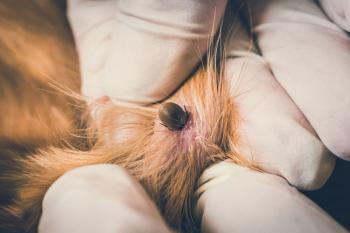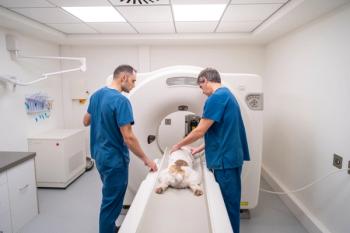
- dvm360 September 2022
- Volume 53
- Issue 9
- Pages: 36
How veterinary dermatology can address canine ear infections
These common conditions often present with cutaneous signs in and around the ear canal
Common in dogs, ear infections can affect the outer, middle, and inner ear. These conditions (otitis externa, media, and interna)1 are a big part of general practice and “a big part of dermatology,” said Meghan Solc, DVM, of Dermatology for Animals in Akron, Ohio, at the 2022 American Veterinary Medicine Association Convention.2
A study published in 2021 found that 7.3% of dogs in the UK have an ear infection every year. The investigators also found that dogs 1 year and older are at higher risk for these infections than those less than 1 year old, that males had 1.21 times the risk of females, and that certain breeds—including Basset Hounds, Chinese Shar Peis, and Labradoodles—are more prone to ear infections.3
Normal vs abnormal
Although most clients don’t immediately think of dermatologists for the treatment of infections of the ear, the organ is “360 degrees of skin,” Solc pointed out. Symptoms of ear infection commonly include crusting, scabbing, and redness and inflammation of the skin inside the ear, discharge (yellow, brown, or bloody), and a bad smell. Scratching or pawing their ears, rubbing them against furniture, and shaking or tilting the head may also indicate infection. More severe cases may cause a loss of balance or hearing, unusual eye movement, and walking in circles.2
By “knowing what is normal, we can…look for [the] abnormal,” Solc said. An exam should start with the outer ear, she stated, adding that “if you can’t even get a Q-tip down there…let along an otoscope…that’s going to tell you a lot.”1
Treating otitis-induced hearing loss
Hearing loss due to ear infection may be classified as conductive, sensorineural, or a combination of both.4 The first can occur in the presence of exudates, stenosis, or glandular hyperplasia.1,4 In conductive cases, hearing can be restored by cleaning the external ear canal.4
“We have to show the client how to properly clean the ear,” Solc said, explaining that the process in her practice includes filling the ear with fluid, holding it out like a cup, and massaging its side; “you’re going to hear that squishing sound.”1 She then wipes off the excess fluid with a piece of gauze, checks to see what is on it, and allows the animal to shake its head to rid itself of leftover fluid, exudates and debris.1
Reducing the inflammation with medicated drops or anti-inflammatory and resolving the infection with antibiotics will also improve the dog’s hearing.4,5 But animals with more severe infections may need repeated treatments.5
If hearing does not return after treatment for an ear infection, the deafness may be due to underlying conditions like allergies, thyroid disease, or adrenal disease.4
However, sensorineural hearing loss may result with inner ear infection when the cochlea nerve pathways to the brain are damaged by infection.4,6 This type of hearing loss is not reversible.6
Conclusion
In the British study, investigators noted that because many dogs do not communicate chronic pain, they were trying to raise awareness about ear infections among pet owners. Likewise, veterinary professionals can teach clients about the frequency of canine ear infections, help them identify their signs, and encourage them to seek early care for their animals if they suspect an ear infection.3
References
- What are the signs of ear infections in dogs? New Ulm Regional Veterinary Center. September 15, 2021. Accessed August 15, 2022.
https://www.nurvc.com/site/blog/2021/09/15/what-are-the-signs-of-ear-infections-in-dogs - Solc MK. Ears and rears! Yes, they are part of our dermatology practice. Presented at: American Veterinary Medical Association Convention; July 29-August 2, 2021; Philadelphia, PA.
- University of London Royal Veterinary College. Now listen ear: new RVC research reveals the dog breeds most affected by ear infections. VetCompass. September 7, 2021. Accessed August 11, 2022.
https://www.rvc.ac.uk/vetcompass/news/now-listen-ear-new-rvc-research-reveals-the-dog-breeds-most-affected-by-ear-infections - Bajwa J. Canine otitis externa -treatment and complications. Can Vet J. 2019;60(1):97-99.
- Paws & Claws Animal Hospital. 5 causes of hearing loss is dogs. Paws & Claws Animal Hospital. June 13, 2018. Accessed August 12, 2022.
https://pawsandclawsanimalhospital.com/5-causes-of-hearing-loss-in-dogs/#:~:text=If%20the%20infection%20has%20caused,medication%20(natural%20or%20conventional) - Strain GM. Deafness in animals. Merck Veterinary Manual. January 2020. Updated October 2020. Accessed August 15, 2022.
https://www.merckvetmanual.com/ear-disorders/deafness/deafness-in-animals
Articles in this issue
over 3 years ago
We DO talk about Bruno (and Clifford and Wininger)over 3 years ago
Dream team creates their ideal veterinary clinicover 3 years ago
The Dilemma: Whom should I hire?over 3 years ago
5 questions to answer if you’re considering practice managementover 3 years ago
What to know before taking out a loan to purchase a practiceover 3 years ago
Understanding laparoscopy in veterinary surgeryover 3 years ago
Team building is crucial to a successful practiceover 3 years ago
Managing acral lick dermatitis in caninesNewsletter
From exam room tips to practice management insights, get trusted veterinary news delivered straight to your inbox—subscribe to dvm360.




